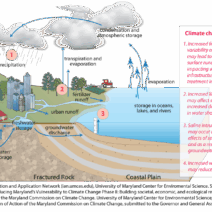Climate change is an omnipresent issue, fundamentally altering the very fabric of our environment. Its tentacles reach into forests, oceans, and cities, manifesting distinct yet interconnected changes that compel us to reevaluate our understanding of ecological processes. In this exploration, we will delve into how climate change reshapes these critical domains, unveiling the intricate interplay between human activities and the planet’s natural systems.
Forests, often referred to as the lungs of our planet, are undergoing transformative shifts predominantly influenced by rising global temperatures and changing precipitation patterns. The synergy of prolonged droughts and increased carbon dioxide levels catalyzes the growth of certain tree species while debilitating others. This phenomenon leads to a reduction in biodiversity, as dominant species outcompete their less resilient counterparts. For instance, the encroachment of invasive species, fostered by warmer climates, can drastically alter native forest ecosystems, resulting in compromised habitats for myriad organisms.
Moreover, these altered forests face a heightened vulnerability to pest outbreaks and wildfires. Warmer temperatures allow pests such as bark beetles to proliferate unchecked, causing widespread tree mortality. In addition, the frequency and intensity of wildfires have escalated alarmingly, driven by both drier conditions and the accumulation of combustible materials from dying trees. The ramifications extend beyond the immediate destruction: carbon that was previously sequestered in these forests is released back into the atmosphere, exacerbating the very issue these ecosystems once helped mitigate.
As the forests succumb to the dual threats of climate change and anthropogenic pressures, their ability to act as carbon sinks diminishes, creating a vicious cycle of environmental degradation. This means that the role of forests in combating climate change is increasingly compromised, which challenges our fundamental understanding of their contributions to global climate stability.
On the other side of the equation lies the ocean, which is arguably the most affected ecosystem by climate change. The ocean acts as a massive carbon sink, absorbing approximately a quarter of the world’s carbon dioxide emissions. However, this assimilation comes with repercussions. Increased absorption of CO2 results in ocean acidification, which disrupts the delicate balance of marine life. Coral reefs, biodiverse marine sanctuaries, are particularly vulnerable; they experience bleaching events induced by rising sea temperatures, which lead to mass mortality of coral polyps and a breakdown of the complex ecosystems that depend on them.
The cascade of consequences does not stop at corals. Marine species are forced to migrate towards cooler waters, disrupting traditional fishing patterns and threatening the livelihoods of coastal communities. Fish populations, integral to global food security, are declining or shifting, making it imperative to reassess marine resource management practices. As fish stocks dwindle, competition among communities amplifies, leading to potential conflicts over dwindling resources.
Furthermore, rising sea levels threaten coastal cities, which are increasingly becoming battlegrounds for climate resilience. The phenomenon of climate-induced urban flooding has escalated, as storm surges combine with high tides and heavy precipitation events. Cities like New Orleans and Miami exemplify the urgent need for adaptive strategies. These urban centers must confront the reality of their vulnerable geographic positioning and implement infrastructural changes that can withstand the onslaught of living with water rather than against it.
Moreover, the urban heat island effect exacerbates the impacts of climate change on cities. As urban areas become increasingly populated with impervious surfaces, such as concrete and asphalt, they absorb and retain heat, creating localized temperature increases. This phenomenon leads to enhanced energy consumption for cooling, particularly during the blistering summer months. The consequences of such increased demand on energy resources are twofold: higher greenhouse gas emissions from power generation facilities, and compounded heat stress on vulnerable populations who lack access to cooling facilities or healthcare.
The intertwined fates of forests, oceans, and cities under the influence of climate change present a complex tapestry of challenges and opportunities for societal response. The reality we face demands a paradigm shift; we must transition from a reactive to a proactive stance on environmental management. Agility in policy formulation and implementation is crucial, allowing for a holistic approach that incorporates not only technological advancement but also indigenous and traditional ecological knowledge.
Innovative solutions are emerging from various quarters. Advances in reforestation and afforestation practices aim to restore degraded landscapes while also fortifying ecosystems against climatic fluctuations. In the marine context, the establishment of marine protected areas is gaining momentum, safeguarding vital habitats while enabling populations to recover from over-exploitation.
Urban areas are beginning to recognize the potential of green infrastructure as a dual solution for climate adaptation and mitigation. This includes integrating green roofs, permeable pavements, and urban forestry initiatives that can reduce heat, improve air quality, and manage stormwater runoff effectively.
As we grapple with the escalating reality of climate change, understanding how it alters the environment is not merely an academic exercise. It bears profound implications for policy, economics, and societal well-being. The intricate links between forests, oceans, and cities underline the necessity of collaborative efforts across all sectors of society. Humanity stands at a critical juncture, armed with the knowledge and technology to effect change. The question remains: will we seize the opportunity to redefine our relationship with the natural world, or allow complacency to guide our fate?
